Running With Ninjas [Justin Hogie] – $0.99
Number of Results: 14
 Shoot-em-ups are really thriving in the AppStore. But with Cave pretty much having a monopoly on the high-end, extremely polished side of things, it’s hard for others to really compare to the insanely high quality they bring to the table. Fortunately, there are some developers that can compete with this, Taito being one of them. The release of Space Invaders: Infinity Gene, and ports of DariusBurst and RayForce are considered to be some of the best non-Cave shmups available on the iOS, and with good reason. The gameplay, graphics, music and amount of polish are all top-notch. And now they’ve added one more game to the list of ports to hit the AppStore; RayStorm. Originally released for the PSX, SEGA Saturn, and for Arcades, it’s also been ported over to Windows, XBLA and the Playstation Network, it’s now available for your iDevice.
Shoot-em-ups are really thriving in the AppStore. But with Cave pretty much having a monopoly on the high-end, extremely polished side of things, it’s hard for others to really compare to the insanely high quality they bring to the table. Fortunately, there are some developers that can compete with this, Taito being one of them. The release of Space Invaders: Infinity Gene, and ports of DariusBurst and RayForce are considered to be some of the best non-Cave shmups available on the iOS, and with good reason. The gameplay, graphics, music and amount of polish are all top-notch. And now they’ve added one more game to the list of ports to hit the AppStore; RayStorm. Originally released for the PSX, SEGA Saturn, and for Arcades, it’s also been ported over to Windows, XBLA and the Playstation Network, it’s now available for your iDevice.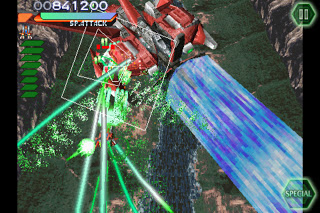 Priced at $8.99, and including GameCenter integration with 4 leaderboards, one for each ship in each mode, along with 31 achievements, chances are, even though it’s one of the better previously released shmups ported over to the iOS, only hardcore fans of the genre will wind up purchasing it. If you’re new to the genre, you might want to check out some of the cheaper titles before diving right in, but for fans of the genre, RayStorm is a great game, and is really only out-done by Cave’s titles. Taito has shown, once again, why they have been around since 1953, are still highly respected, and have a very loyal fan following.
Priced at $8.99, and including GameCenter integration with 4 leaderboards, one for each ship in each mode, along with 31 achievements, chances are, even though it’s one of the better previously released shmups ported over to the iOS, only hardcore fans of the genre will wind up purchasing it. If you’re new to the genre, you might want to check out some of the cheaper titles before diving right in, but for fans of the genre, RayStorm is a great game, and is really only out-done by Cave’s titles. Taito has shown, once again, why they have been around since 1953, are still highly respected, and have a very loyal fan following.
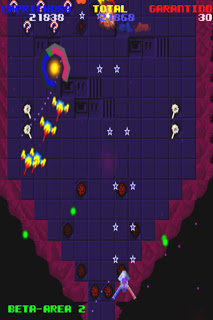 Jeff Minter is sort of a God in the gaming industry. Founder of Llamasoft, he’s been in the business for over 30 years, and has developed numerous games for the Sinclair XZ81, Commodore VIC-20, Atari 2600, ZX Spectrum, Commodore 64, Atari ST, Atari 400/800, Pocket PC, XBLA, PC, and iDevice. Some classic games you might have heard of; Tempest 2000 – 3000 – X3, Traxx, Sheep in Space, Hover Bovver, Abductor, Trip-a-Tron, Virtual Light Machine and loads more. On the iOS, he’s ported over the classics, Minotron: 2112, Minotaur Rescue, Deflex, Caverns of Minos and Gridrunner. He’s best known for his inclusion of llamas, sheep, camels, oxen, and his psychedelic graphics. But his most recent release, Super Ox Wars, an Ikaruga influenced polarity shoot-em-up, could be considered one of his best iOS releases to date. On the distant planet, Parint, two oxen are revered by the people. With each ox representing a valuable characteristic of the society, each person chooses one ox to guide their spirit. Parint was invaded by the Marcab Empire, who enslaved the people. It’s up to you to save the people, and your planet by using the power of the oxen.
Jeff Minter is sort of a God in the gaming industry. Founder of Llamasoft, he’s been in the business for over 30 years, and has developed numerous games for the Sinclair XZ81, Commodore VIC-20, Atari 2600, ZX Spectrum, Commodore 64, Atari ST, Atari 400/800, Pocket PC, XBLA, PC, and iDevice. Some classic games you might have heard of; Tempest 2000 – 3000 – X3, Traxx, Sheep in Space, Hover Bovver, Abductor, Trip-a-Tron, Virtual Light Machine and loads more. On the iOS, he’s ported over the classics, Minotron: 2112, Minotaur Rescue, Deflex, Caverns of Minos and Gridrunner. He’s best known for his inclusion of llamas, sheep, camels, oxen, and his psychedelic graphics. But his most recent release, Super Ox Wars, an Ikaruga influenced polarity shoot-em-up, could be considered one of his best iOS releases to date. On the distant planet, Parint, two oxen are revered by the people. With each ox representing a valuable characteristic of the society, each person chooses one ox to guide their spirit. Parint was invaded by the Marcab Empire, who enslaved the people. It’s up to you to save the people, and your planet by using the power of the oxen.
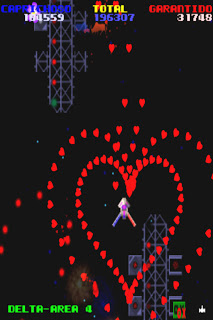 As you play through each of the 7 levels, you’ll be able to collect either blue/star or red/heart colors and items. In order to go for a high score, you’ll need to decide which color you want to stick with while going through the stages. As you collect more items from one of the two colors, your firepower will increase, as well as defensive powers; Hearts push back enemy projectiles around your ship, while Stars cause your own shots to push back enemy projectiles. As you collect more items of one color, more power-ups and extra lives will drop more often, but once you collect an item of the opposite color, the polarity is automatically shifted.
As you play through each of the 7 levels, you’ll be able to collect either blue/star or red/heart colors and items. In order to go for a high score, you’ll need to decide which color you want to stick with while going through the stages. As you collect more items from one of the two colors, your firepower will increase, as well as defensive powers; Hearts push back enemy projectiles around your ship, while Stars cause your own shots to push back enemy projectiles. As you collect more items of one color, more power-ups and extra lives will drop more often, but once you collect an item of the opposite color, the polarity is automatically shifted. You’re given 3 different scores at the top of the screen, one for blue, one for red, and one for a combined score. Each of the scores increase depending on your current polarity, so if you’re using blue, your blue score will rise, and if you’re using red, your red score will rise. Both of these are combined together for your total score. Shooting down entire groups of enemies gives you bonuses, and destroying all of the flying enemies in each stage will give you an end of level bonus.
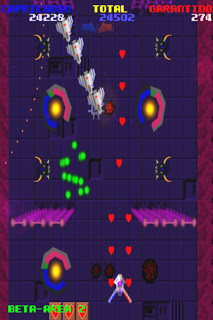 The graphics and animations are typical of Minter’s past releases, but are not as incredibly crazy. You’re able to very clearly make out enemy ships, and background objects, but there is a psychedelic level to the images, with loads of stars or hearts flying out of your ship when your ship is fully powered up, or explodes, and the animations are reminiscent of Gridrunner. The controls, however, are a very tight and smooth relative touch control scheme at a 1:1 ratio. GameCenter is supported, and with 4 separate leader boards, one for each color, one for a pure run (starting on stage 1), and one for your combined score, as well as 10 achievements, it definitely adds to the already high replay value of the game. Priced at $1.99, and being a Universal build, Super Ox Wars is a fantastic, as well as cheap, polarity based shmup. Fans of the genre, and especially fans of Minter titles, should pick this one up. Though not as psychedelic graphically, and only containing one gameplay mode, it’s one of the most challenging Llamasoft games I’ve ever had the pleasure of playing, will definitely get loads of gameplay out of me and will wind up staying on my device for a long time.
The graphics and animations are typical of Minter’s past releases, but are not as incredibly crazy. You’re able to very clearly make out enemy ships, and background objects, but there is a psychedelic level to the images, with loads of stars or hearts flying out of your ship when your ship is fully powered up, or explodes, and the animations are reminiscent of Gridrunner. The controls, however, are a very tight and smooth relative touch control scheme at a 1:1 ratio. GameCenter is supported, and with 4 separate leader boards, one for each color, one for a pure run (starting on stage 1), and one for your combined score, as well as 10 achievements, it definitely adds to the already high replay value of the game. Priced at $1.99, and being a Universal build, Super Ox Wars is a fantastic, as well as cheap, polarity based shmup. Fans of the genre, and especially fans of Minter titles, should pick this one up. Though not as psychedelic graphically, and only containing one gameplay mode, it’s one of the most challenging Llamasoft games I’ve ever had the pleasure of playing, will definitely get loads of gameplay out of me and will wind up staying on my device for a long time.
![]() Shoot-em-ups have expanded quite a bit since Cave hit the iOS scene in April of 2010. However, very few games have done what Cave’s releases have done for the scene, so it’s nice to see a developer realize this, and take the genre in completely different direction. DarkWave Game’s new title, Act of Fury: Kraine’s Revenge, is a different kind of shmup for fans of the genre. A game in which, instead of shooting your enemies down, you get as close to them as you can, disabling their systems, and taking them down with a tornado like force that surrounds you.
Shoot-em-ups have expanded quite a bit since Cave hit the iOS scene in April of 2010. However, very few games have done what Cave’s releases have done for the scene, so it’s nice to see a developer realize this, and take the genre in completely different direction. DarkWave Game’s new title, Act of Fury: Kraine’s Revenge, is a different kind of shmup for fans of the genre. A game in which, instead of shooting your enemies down, you get as close to them as you can, disabling their systems, and taking them down with a tornado like force that surrounds you.
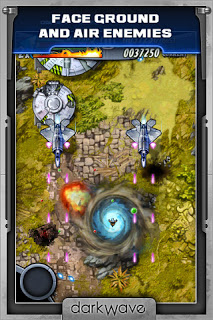 To start things off, the graphics in Act of Fury are great. I have run into some slight jumping around of the screen when the levels start to scroll left or right, or zoom in and out, like when an air-strike comes in, however it’s nothing game-breaking, but is noticeable, and should be brought up. Aside from this, the variety with enemies is nice, the 4 different environments look great, and the animations are fantastic. The music and sounds go along nicely in passing on the feel of the world in Act of Fury as well.
To start things off, the graphics in Act of Fury are great. I have run into some slight jumping around of the screen when the levels start to scroll left or right, or zoom in and out, like when an air-strike comes in, however it’s nothing game-breaking, but is noticeable, and should be brought up. Aside from this, the variety with enemies is nice, the 4 different environments look great, and the animations are fantastic. The music and sounds go along nicely in passing on the feel of the world in Act of Fury as well.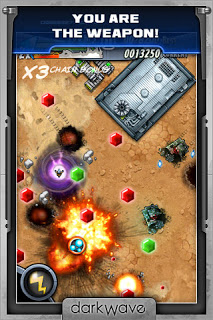 Act of Fury is a very interesting addition to the shmup genre. It does a fantastic job of mixing the Spirit/Bit Pilot/Silverfish type mechanics with shmup influenced gameplay, and presenting it all in an extremely polished and well rounded package. There are GameCenter and OpenFeint leader boards for each of the 9 stages in both Normal and Hell Modes, as well as a total score leader board for both Modes, along with 32 achievements, all adding immensely to the replay value, which, once you get into the Hell Mode levels, is already fairly high. With the price being $2, it’s definitely a game that’s worth every penny, and then some, especially if you’re a fan of the shoot-em-up genre. Act of Fury also runs on 2nd GEN devices, which, with this genre, is fantastic news.
Act of Fury is a very interesting addition to the shmup genre. It does a fantastic job of mixing the Spirit/Bit Pilot/Silverfish type mechanics with shmup influenced gameplay, and presenting it all in an extremely polished and well rounded package. There are GameCenter and OpenFeint leader boards for each of the 9 stages in both Normal and Hell Modes, as well as a total score leader board for both Modes, along with 32 achievements, all adding immensely to the replay value, which, once you get into the Hell Mode levels, is already fairly high. With the price being $2, it’s definitely a game that’s worth every penny, and then some, especially if you’re a fan of the shoot-em-up genre. Act of Fury also runs on 2nd GEN devices, which, with this genre, is fantastic news.
![]() The Tilt To Live and Shmup genres have been mashed together a few times, and have had extremely nice results. FlipShip and Blue Attack come to mind right off the bat. Though it’s no surprise really, as the whole Tilt To Live genre is basically bullet hell without any bullets, dodging and weaving through enemies like you would a bullet onslaught in a Cave title. True Axis (Jet Car Stunts) is the most recent publisher to see the potential with this genre, as they’ve released PomPom’s title, Space Tripper, their highly anticipated iOS port of the PSN and PC game, Astro Tripper.
The Tilt To Live and Shmup genres have been mashed together a few times, and have had extremely nice results. FlipShip and Blue Attack come to mind right off the bat. Though it’s no surprise really, as the whole Tilt To Live genre is basically bullet hell without any bullets, dodging and weaving through enemies like you would a bullet onslaught in a Cave title. True Axis (Jet Car Stunts) is the most recent publisher to see the potential with this genre, as they’ve released PomPom’s title, Space Tripper, their highly anticipated iOS port of the PSN and PC game, Astro Tripper.
 In Space Tripper, you’ll shoot and dodge your way through 14 levels, split up across 4 different worlds, of wave-enemy battles, with quite a few boss fights, and even a task or two to mix things up, all building up to a final boss battle that could very well cause your heart to explode from adrenaline. One of the first things you might notice about Space Tripper, if you’ve never played it before, is that it is set up more like a shooter than a Tilt To Live type game, making it more reminiscent of Blue Attack than FlipShip or any other TTL genre’d title. However, if you go into the game thinking it’s going to play like your typical shooter, you’ll be in for quite a surprise, and maybe even disappointment.
In Space Tripper, you’ll shoot and dodge your way through 14 levels, split up across 4 different worlds, of wave-enemy battles, with quite a few boss fights, and even a task or two to mix things up, all building up to a final boss battle that could very well cause your heart to explode from adrenaline. One of the first things you might notice about Space Tripper, if you’ve never played it before, is that it is set up more like a shooter than a Tilt To Live type game, making it more reminiscent of Blue Attack than FlipShip or any other TTL genre’d title. However, if you go into the game thinking it’s going to play like your typical shooter, you’ll be in for quite a surprise, and maybe even disappointment. 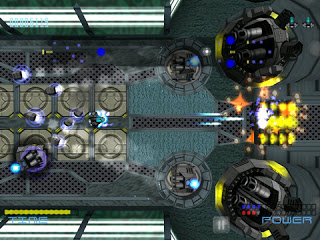 Gamers have been waiting for this iOS port of Astro Tripper for quite some time, and even if you’ve got Astro Tripper, the gameplay in Space Tripper is different enough with the tilt controls that it’s basically a new gameplay experience. You’ll need to change your strategy, as tactics that are memorized, and fairly easy to pull off with a controller, are not to easy to pull off on a device utilizing tilt controls. $3.99 for this Universal game is a great deal, and one that any arcade, old-school, shmup, Tilt To Live, or adrenaline fanatic should jump on immediately. PomPom has definitely shown that they are the equivalent of Cave Inc. within the Tilt To Live genre.
Gamers have been waiting for this iOS port of Astro Tripper for quite some time, and even if you’ve got Astro Tripper, the gameplay in Space Tripper is different enough with the tilt controls that it’s basically a new gameplay experience. You’ll need to change your strategy, as tactics that are memorized, and fairly easy to pull off with a controller, are not to easy to pull off on a device utilizing tilt controls. $3.99 for this Universal game is a great deal, and one that any arcade, old-school, shmup, Tilt To Live, or adrenaline fanatic should jump on immediately. PomPom has definitely shown that they are the equivalent of Cave Inc. within the Tilt To Live genre.